分享到微信,
请点击右上角。
再选择[发送朋友]
或[分享到朋友圈]

一个艺术家倘若能够从浩瀚的传统文化体系中找到一个独特视角并创造性地表达对这个世界的某些本质性关系的理解——已属非凡;而这样的突破对于傅中望先生而言至今已经发生了二次——堪称杰出。
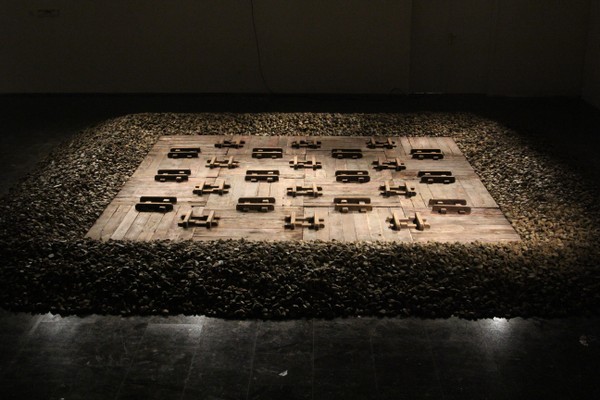
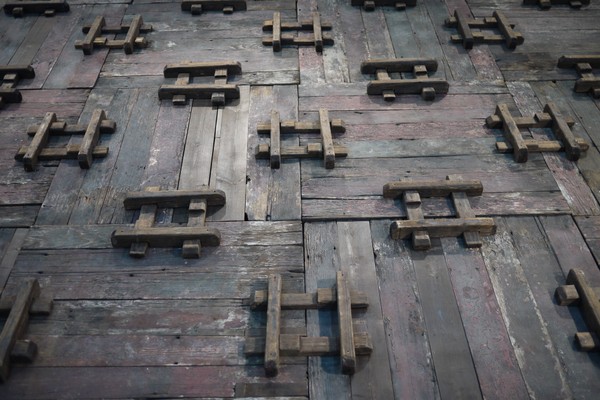
《榫卯结构•地门》600cm×600cm×20cm,木、石,1994
从上世纪80年代开始,傅先生就凭借系列“榫卯结构”的雕塑形态作品在中国当代艺术的发初时期独树一帜。从中国传统民俗木工制作中的部件连接工艺技法中发现具有揭示人类社会普遍结构性契合关系的方法——既让西方文化中心主义看到了博大精深的中华传统智慧内核,又让正努力学习西方现代文化的同时坚守文化本土立场者看清了轻视自己历史传统的荒谬——这正是“榫卯结构”的当代艺术史意义。
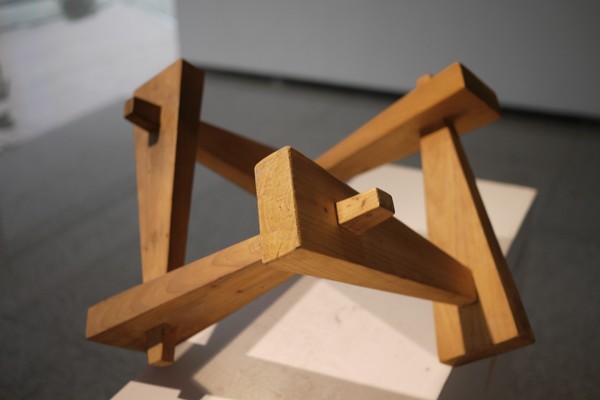
《楔子6#》 木 30cmX50cmX50cm 木 1993
早在1991年,中望先生的作品中就曾出现过“楔子”。也曾引起过评论界的关注。而“楔子”的那一次“偶然”出现很大程度上只是“榫卯”关系表达的某种延续,还难以看作是其艺术思想跨越的“必然”——作为一种独特艺术现象的存在。
从2007年7月至2017年3月,中望先生担任湖北美术馆创始馆长,将艺术生涯中十分宝贵的10年奉献给了公共文化事业。对于一个艺术家而言,这一举动通常会被看作是一种牺牲。而依我看,若一定要说牺牲,也是一个阶段性经济利益的牺牲,而不是创造力的牺牲,更不是艺术灵魂的牺牲。他以一种超脱于世俗的方式离开艺术创作的常态,进入更为广阔的艺术思想状态——这是一个积攒文化能量的过程。艺术家的历史——创作可以因为种种原因而中断,身份可以被随机定义和解读,而对艺术的思考始终不会中止。
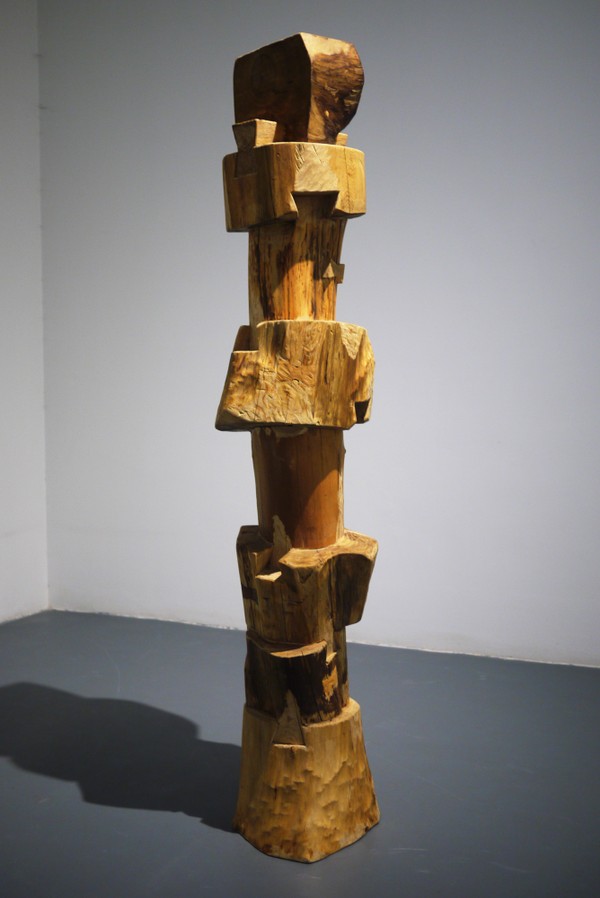
《桓柱》 高225cm 宽60cm 木 2015
显然,中望先生不愿意艺术生命止步于过去的辉煌,也不愿意曾经的艺术成果在过去时中被符号化和标签化。他一直在寻求新的突破。深谙纷纭复杂的社会文化关系是实现这种突破的基础。《楔子》可以看作中望先生在达到“榫卯结构”的创造高峰之后的又一次艺术才华的集中爆发。楔子——作为一种依存物和辅助物,却蕴含着改变事物本质的巨大能量;通常被用于发挥建设性、协调性作用,却潜藏着否定性,破坏性的锋芒;貌似平凡,却有可能成为关键时刻的决定性因素。
不确定性是产生艺术效果的天然契机。将“楔子”的物理学意义赋予社会性内涵及审美意义——这正是中望先生近几年思考艺术问题的焦点和工作的价值核心。奇妙之处在于,生活中无所不在的“楔子”本身似乎平淡无光,可一旦与其它物体发生结构性关系就能瞬间产生奇迹般的视觉时空转换效应——这正是傅中望先生独到的艺术发现。我看可以称之为“关系艺术”。
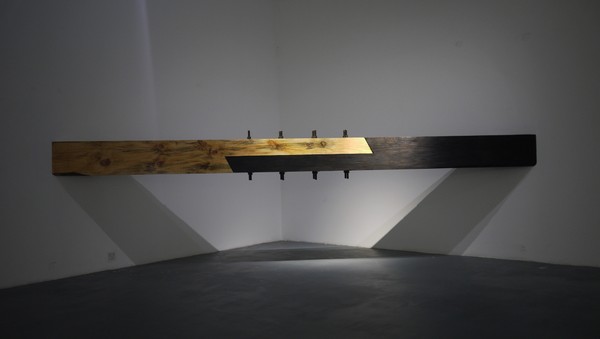
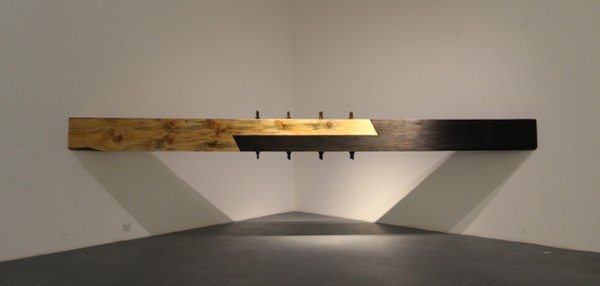
《穿梁》 傅中望 木 588cm×40cm×40cm 2014
一年前,因为地铁的修建,在合美术馆正面的广场前意外出现了一个作为逃生出口的建筑物,不仅缺乏视觉美感,而且显得格外突兀,直接影响到美术馆的形象观瞻。我们希望改变由此带来的空间视觉关系的恶化,曾邀请中望先生为此做一个艺术的解决方案。他就用到了一只桀骜不驯的“楔子”——仅从方案效果看,就完全可以消解在无序中出现的这种公共建筑的突兀。遗憾的是,这一独特创意直到目前尚未实施并有可能付诸东流。这次展览,中望先生直接将5个楔子“插进”美术馆的建筑的不同部位,尝试不同质感的视觉形式在公共艺术空间的共生与同构。通过改变这座建筑的视觉观感——司空见惯中的陌生感——隐喻某种意料之外但不容忽视的力量。这件作品在展览中出现,没有附加任何宣言,而在我看来,它的构思与出现本身就是一种宣言。更为重要的是,它足以提示人们,在任何条件下都不可缺失自我批评和自我否定的精神。
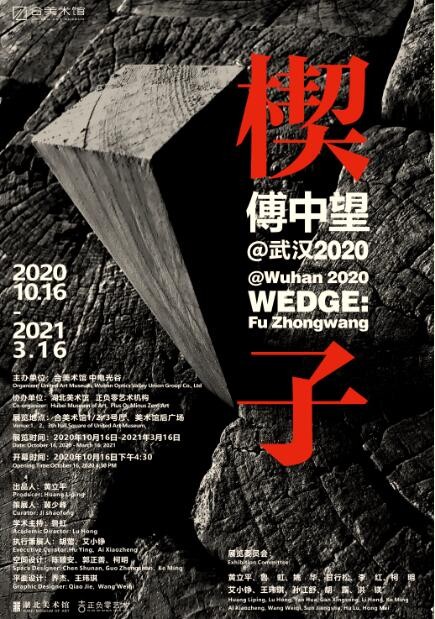
从“榫卯”到“楔子”——既是一种转型,更是一种升维,从中可以洞见中望先生旺盛的艺术生命力。由“楔子”追溯“榫卯”——既是一种回望,更是一种蜕变,从中可以理解中望先生艺术思维的整体性和一致性。我对这相隔30年的对话充满了期待,也预期中望先生的主观能动性在布展和展出现场还会出现令人惊叹的“神来之笔”。相信这个展览能够成为合美术馆推动当代艺术创新发展的又一个里程碑。
(作者为合美术馆馆长)
Fu Zhongwang’s Relational Art
By Huang Liping
If an artist is able to find a unique perspective from the extensive traditional cultural system and creatively express his understanding of some essential relations of the world, then the artist is nothing short of extraordinary; Mr. Fu Zhongwang has made two such breakthroughs so far, which makes him outstanding.
Since the 1980s, the early days of Chinese contemporary art, Mr. Fu has had a style of his own by virtue of his sculpture works in the form of mortise and tenon joint. He discovers a method to reveal the universal compatible structural relation in human society, which facilitates not only Western cultural centralism to notice the wisdom of Chinese traditions, but also those who are trying to learn Western modern culture and at the same time adhere to the position of cultural localization to see the absurdity of despising their own historical traditions. This is exactly the significance of mortise and tenon joint in contemporary art history.
As early as in 1991, wedge already appeared in Mr. Fu’s work, which once attracted critical attention. However, the “accidental” appearance of “wedge” was largely a continuation of the expression of mortise and tenon joint, which could hardly be regarded as the “inevitability” of his artistic thinking—it merely existed as a unique artistic phenomenon at that time.
From July 207 to March 2017, Mr. Fu served as the founding director of Hubei Museum of Art, devoting 10 precious years of his artistic career to the cause of public culture. Such an act is usually considered as a sacrifice for an artist. But in my opinion, if we have to regard it as a sacrifice, it is a sacrifice of staged economic benefits, but not a sacrifice of creativity, not to mention a sacrifice of artistic soul. He replaced the normal state of artistic creation with a broader state of artistic thinking in a way beyond the mundane, which is a process of accumulating cultural energy. An artist’s past records, or, creation, may be interrupted for various reasons, and identity may be randomly defined and interpreted, but his thinking about art will never stop.
Obviously, Mr. Zhongwang doesn’t want his artistic life to rest on its past glories, and is unwilling to see his artistic achievements to be symbolized and labelled in the past tense. Hence, he keeps seeking for new breakthroughs, knowing deeply that the complex social and cultural relations are the basis for such breakthroughs. Wedge can be deemed as another peak of Mr. Fu’s artistic talent after he reached the creative peak of “mortise and tenon joint structure”. As an appendant and auxiliary, wedge contains tremendous power to change the nature of things; it usually plays a constructive and coordinating role, but conceals its negativity and destructiveness; ordinary though it seems, it could be a deciding factor at a critical moment
Uncertainty is a natural opportunity to generate artistic effects. To endow the physical significance of “wedge” with social connotation and aesthetic meaning is the focus of Mr. Zhongwang’s artistic research and core value of his work. What is interesting is that the ubiquitous “wedge” itself seems dull in life, but when it has a structural relationship with other objects, it can instantly produce miraculous visual space-time transformation effects, which is the unique artistic discovery of Mr. Fu Zhongwang. I think it can be called “relational art”.
A year ago, due to the construction of the subway, a building designed to be an escape exit unexpectedly appeared in front of the square in front of United Art Museum, which not only destroyed the visual sense of beauty, but was also extremely abrupt, directly affecting the image of the art museum. In this case, we hoped to improve the deterioration of spatial visual relations and invited Mr. Fu for an artistic solution. He used a rebellious “wedge” in the scheme, which completely eliminated the abruptness of similar public buildings that appeared in disorder. Unfortunately, this unique idea has not been implemented until now and may be in vain. In this exhibition, Mr. Zhongwang directly “inserts” five wedges into different parts of the building of United Art Museum, trying to make visual forms with different textures symbiotic and isomorphic in public art space. By changing the visual impression of this building, namely, the familiar strangeness, some unexpected but not negligible force is hidden. This work is exhibited without any declaration attached. As far as I can see, its conception and appearance are a declaration. More importantly, it is enough to remind people that the awareness of self-criticism and self-negation should not be lost under any conditions.
From “mortise and tenon joint” to “wedge”, it is both a transition and a dimension upgrade. During this process, we can catch a glimpse of Mr. Zhongwang’s exuberant artistic vitality. Tracing from “wedge” to “mortise and tenon joint”, it is both a retrospect and a change, from which we can understand the integrity and consistency of Mr. Zhongwang’s artistic thinking. I am full of expectations for this dialogue that has been 30 years apart, and also expect that Mr. Zhongwang’s subjective initiative will give a masterstroke to the exhibition arrangement and exhibition scene. I believe that this exhibition will be another milestone for United Art Museum to promote the innovative development of contemporary art.
(The Author is the Director of United Art Museum)
作者:黄立平

分享到微信,
请点击右上角。
再选择[发送朋友]
或[分享到朋友圈]

